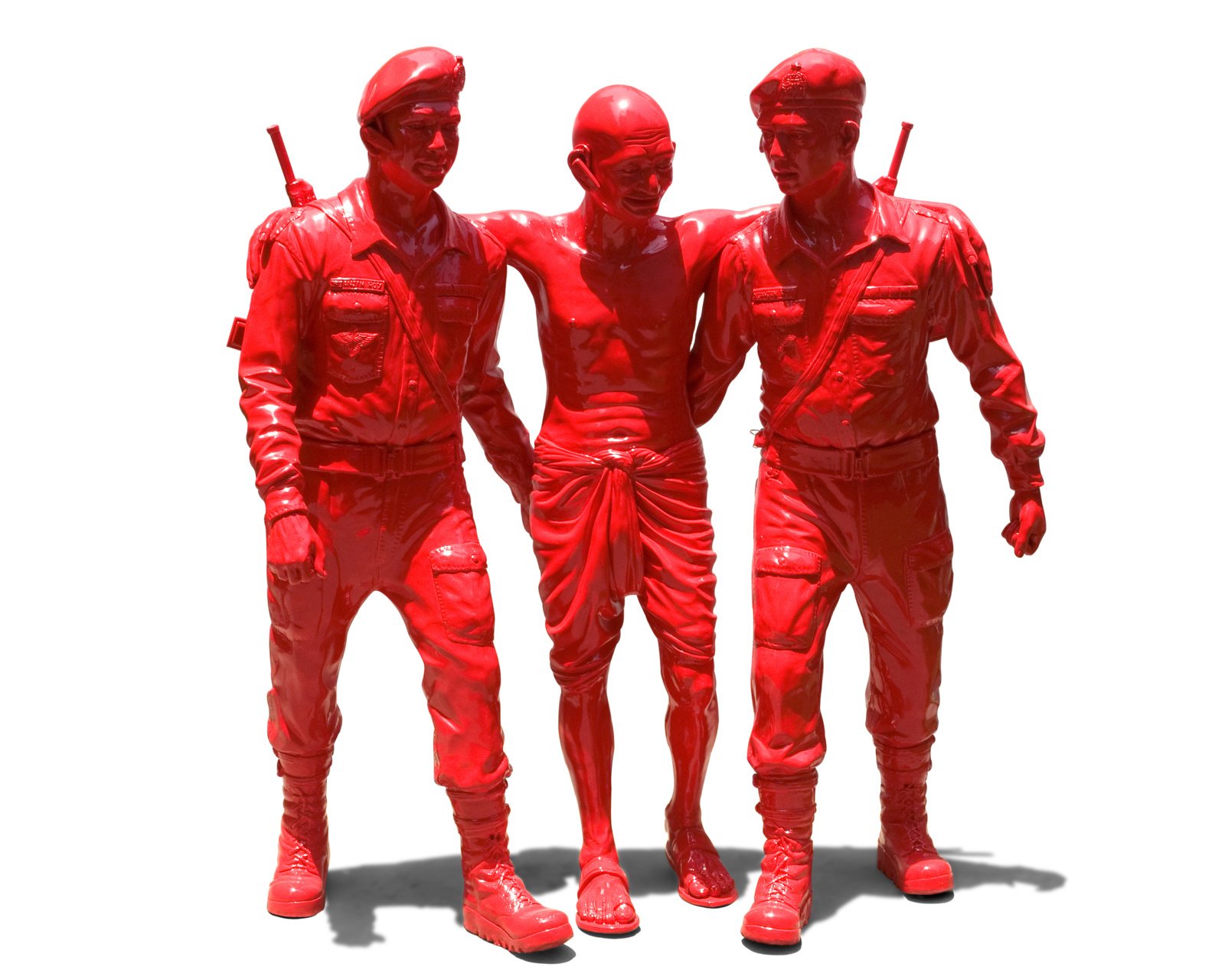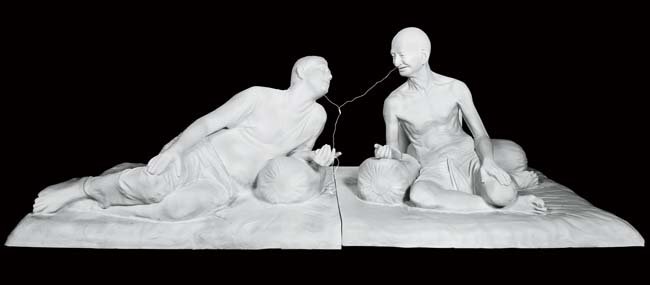
Looking for Bapu - Debanjan Roy
December 2010 at Akar Prakar, Kolkata
In searching for Bapu, Debanjan Roy explores the complexity of Mahatma Gandhi’s politics and their relevance in contemporary India.
Roy depicts Gandhi with a mobile phone walking a pug or as a call centre employee thereby reinventing the venerable ‘Father of the Nation’ using objects and situations symbolic of new India. Popular images conjure many different and incommensurable Gandhis: as human, as divine; or as prophet of ahimsa. These different personae were played out within Gandhi himself, sometimes with turbulent results. In Roy’s works, Gandhi becomes repository of different needs and expectations. Sometimes the works are closely allied with Gandhi’s self-conception as a somatic, physically transparent human vehicle of a divinely inspired morality. Also, the use of red enhances a truth already present in the image: the humility and truthfulness of Gandhi’s androgynous corporeal rebuke to the brutal masculinity of oppression and violence in contemporary India.
Largely based on photographic referents, the works are not scaled down and viewers find themselves confronted with life-size Gandhis who are projected emerging auratically but contemporized. In one case, the reference – the iconic photograph of the Mahatma and Pandit Nehru – is woven into the work and the recontextualization – which depicts the artist and Gandhi sharing a tune on an iPod – acquires a far more significant meaning. These are images which consolidate a view of Gandhi which Gandhi himself might have affirmed: human, and involved in an experiment with truth. Time and again Roy depicts, with quiet humour, the humility and benign persona of the Mahatma as a seeker of truth in a variety of manifestations. The works beg the audience to search within themselves for definitions of who this man really was: a revolutionary, a reactionary, an idealist, a man of faith, a secular leader, a visionary?
Roy also encourages the viewer to look at Gandhi, the ‘Father of the Nation’, from a variety of perspectives: Gandhi the nationalist; Gandhi the icon; and Gandhi the prophet of non-violence. Gandhi’s peculiar engagement with popular culture, his after-image, and the cult that grew around him during his life and after his death is clearly of particular interest to the artist. The eclecticism of the imagery in this work – in many ways the result of an arbitrary piling up of diverse visual sources – establishes an ambivalent language of quotation and citation that is very much a part of the aesthetic and cultural content of contemporary Indian art.
Since Gandhi was a sovereign, political figure in Indian history who never occupied a specific political office, it becomes important to artistically examine the manner in which a charismatic, personality-based approach intersects with popular media and material practices to produce alternative sites of power that cannot be reduced to or confined within the logic of the sovereign nation state. Roy manages this with considerable flair by, on the one hand, seeking to examine the manner in which the image of Gandhi has been imbued with a specific political, social and cultural content that is deemed to be relevant to the upliftment of a people once downtrodden. On the other, he also seeks to engage with the manner in which, Gandhi, after his death, was absorbed into a nationalist culture that had its own way of interpreting and publicizing his legacy. The significant motif that, therefore, emerges is the manner in which Gandhi resonates as a public icon in mass media and in material culture, as a political figure without designation but not without authority and his relevance in contemporary Indian, indeed global, discourse. It was also of interest to reflect on the innately and very obviously respectful nature of Roy’s works and compare it with the camp disdain and frippery with which Mao Zedong is portrayed in contemporary Chinese art.
Roy also articulates abstract theoretical concepts such as morality or virtue, through creative use of everyday objects. Colourful, extravagant, more than a tad outré and sometimes surreal, to an audience unfamiliar with these cultural references the works may appear kitschy. To those au fait with the references, though, the exhibition offers a critical assessment of the strategic role of the Mahatma and his invocation in art and popular culture and the process by which individual and collective identities are formed.
Anirudh Chari
Debanjan Roy | Bapu walking with the Dog | Fiberglass with Acrylic paint | 46 x 15 x 14 (Bapu) & (11 x 18 x 7 (Dog)
Debanjan Roy | Bapu on the Phone | Aluminum cast paint | 22 x 46 x 30 in
Debanjan Roy | Bapu with Laptop | Aluminum cast paint | 22 x 46 x 30 in
Debanjan Roy | Bapu with iPod| Fiberglass with Acrylic paint | 66 x 32 x 36 in
Debanjan Roy | Bapu on the Moon | Fiberglass with Acrylic paint | 46 x 22 x 18 in
Debanjan Roy | Bapu with Crow | Fiberglass with Acrylic paint | 27 x 16.5 x 11 in
Debanjan Roy | Bapu with Soldiers | Fiberglass with Acrylic paint | 66 x 56 x 24in
Debanjan Roy | Absence of Bapu | Fiberglass with Acrylic paint | 66 x 72 x 48 in
Debanjan Roy | Bapu & me | Fiberglass with Acrylic paint | 36 x 108 x 48 in
Debanjan Roy | Bapu with Goats | Fiberglass with Acrylic paint | Life size
Debanjan Roy
Debanjan Roy Is a promising young sculptor who has achieved quite a prestigious standing in the global art scene. His works have been shown widely in many international art fairs like, the Abu Dhabi Art Fair, Art Dubai, ARCO Art Fair, India Art Summit, Pulse, New York, Art Hong Kong, etc. His works have also sold at auctions of Saffronart, and Sotheby’s.









